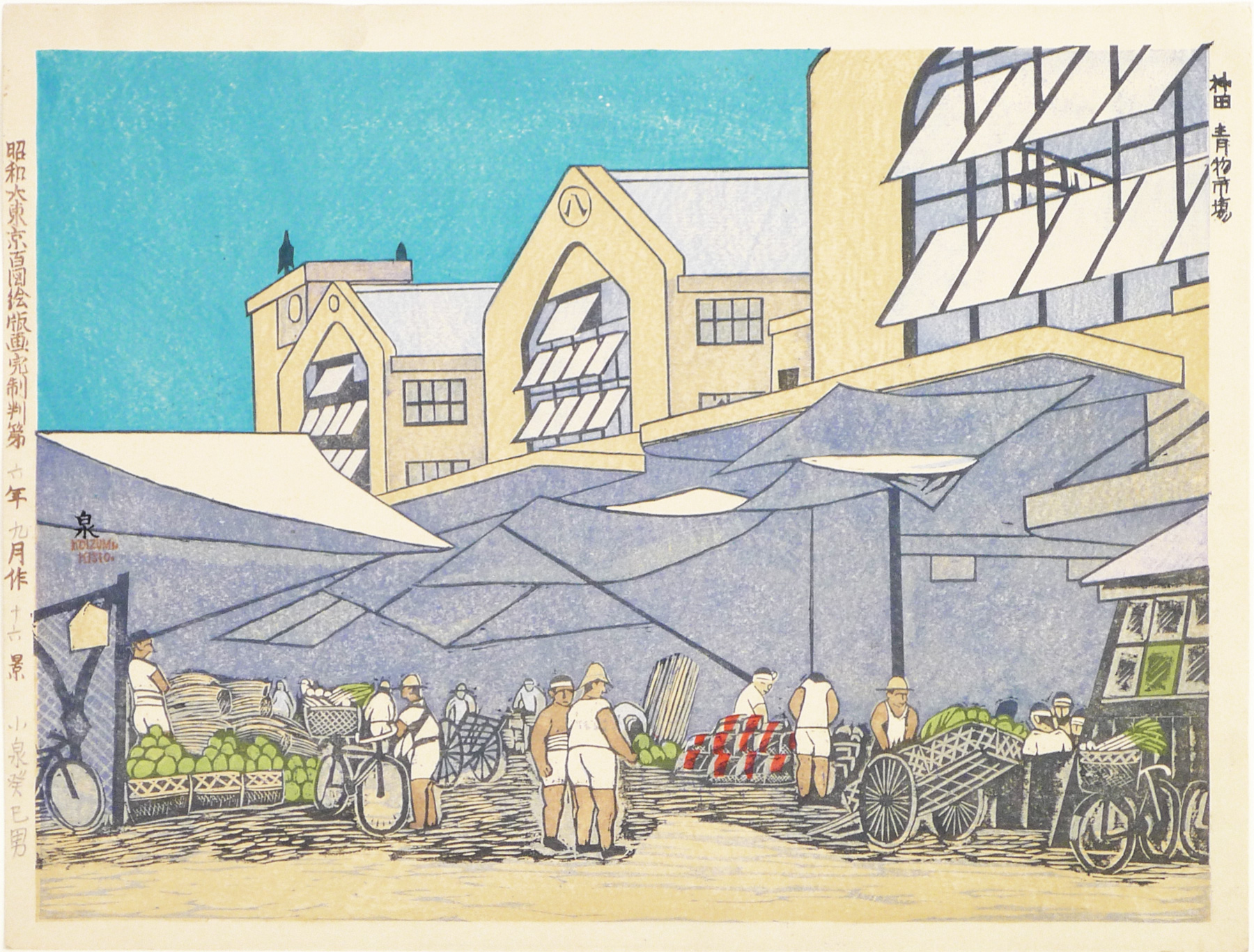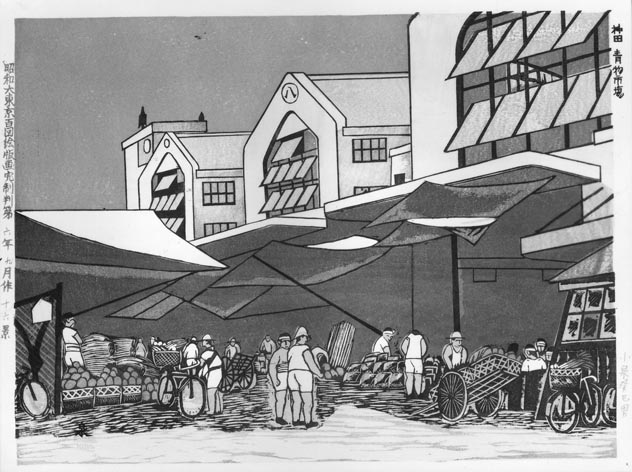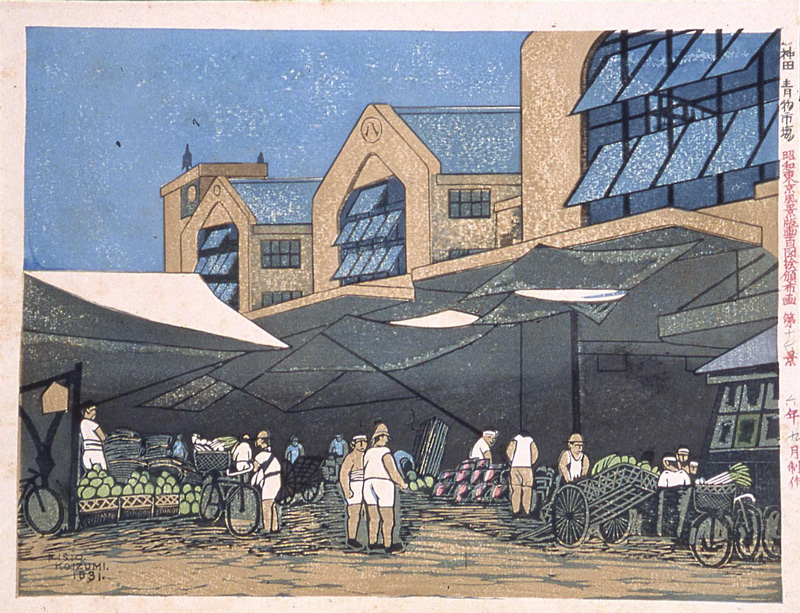About This Print
Number sixteen of the one hundred prints that make up the series Showa dai Tokyohyakuzue (One Hundred Pictures of Great Tokyo During Showa). Koizumi startedthis series in 1928 and completed it twelve years later in 1940.Source: Tokyo: The Imperial Capital Woodblock prints by Koizumi Kishio, 1928-1940, Marianne Lamonaca, The Wolfsonian-Florida International University, 2003, p.49.
"Damage from the earthquake required the reconstruction of Tokyo's wholesale food markets, including the Central Wholesale Market at Tsukiji (completed in 1931) and branch markets in Kanda and Koto (completed in 1930). Vegetable sales were transacted under tented stalls along the Kanda River to facilitate the shipping of goods. In Koizumi's view the massive reinforced concrete-and-glass warehouse - built to withstand future earthquakes and fires - dwarfs the workers and their old-fashioned, manually operated operated bicycles and carts."
"The only hint of agriculture—and the fact that the great majority of Japan’s population was engaged in this—was Koizumi’s rendering of the new central vegetable market in Kanda, and a nostalgic depiction of a post-earthquake suburb where daikon, the succulent big white radish, was still grown."1
For more information on this series see "The Series - One Hundred Pictures of Great Tokyo During Showa (Showa dai Tokyo hyakuzue)" under the artist's biography.
Artist's Annotation
Source: MIT Visualizing Cultures website http://ocw.mit.edu/ans7870/21f/21f.027/tokyo_modern_02/annotation.htmlIn 1940, Koizumi created woodblock print charts containing print titles, dates, and comments for this series. His comment for this print follows:
“Vegetables for all of Tokyo were distributed from this place.”
Other Impressions - Reference Images for this Print
| KOIZUMI, Kishio 1893 - 1945 Vegetable Market in Kanda, 1931 (No.16 of "One Hundred Scenes from Tokyo Metropolis in the Showa Period") color woodcut on paper, 27.8×37.1 cm P00131-007 The National Museum of Modern Art, Tokyo | Plate 7 Vegetable Market at Kanda, September 1931 (from “Tokyo: The Imperial Capital Woodblock prints by Koizumi Kishio, 1928-1940".) Note differences with this collection's print: 1. Color of windows (blue vs. white) 2. Series title in right margin, rather then left margin. 3. Signature is of the form "Kisio Koizumi 1931." |
Kanda Produce Market
Originally chartered as Edo's main produce market, likely in the early 17th century, it was situated near Sujikaibashi Bridge along the Kandagawa River. In 1930, the market was moved just north near Akihabara Station in central Tokyo where it stood until 1989 when it was relocated to Oda City (near the Haneda Airport) and renamed the Ōta Market. The move, however, did not go smoothly and "the relocated vegetable dealers from the old Kanda Market split between a faction that agreed to go along with the move and those who were adamantly opposed, and these two groups are now represented at Ōta by separate federations."2In 2001, "the Tokyo Metropolitan Government sold the former site of the Kanda Produce Market (approximately 16,000 square meters) located next to JR Akihabara station to private contractors for redevelopment, and now Akihabara is being transformed from an electronics district into a major hub of the IT industry."3
1 MIT Visualizing Cultures website http://ocw.mit.edu/ans7870/21f/21f.027/tokyo_modern_01/kk_essay04.html
2 Tsukiji: The Fish Market at the Center of the World, Theodore C. Bestor, University of California Press, 2004, p. 271.
3 The Japan Forum website http://www.tjf.or.jp/eng/content/japaneseculture/30akiba.htm
Print Details
| IHL Catalog | #593 |
| Title | Vegetable Market at Kanda Kanda aomono shijô 神田青物市場 |
| Series | One Hundred Pictures of Great Tokyo in the Showa Era Showa dai Tokyo hyakuzue 昭和大東京百図絵 |
| Reference Number | #16 (artist's annotated portfolio list from c. 1940) |
| Artist | Koizumi Kishio (1893-1945) |
| Signature | Koizumi Kisio (Roman letters) and Izumi character 泉 in image |
| Seal | |
| Publication Date | September 1931, 19th day |
| Edition | Likely first edition given hand written date in left margin. However, color scheme for windows varies (white vs. blue) from other prints. |
| Publisher | likely self-published; some sources list publisher as Asahi Press (see "The Publisher of the Series" under the artist's bio Koizumi Kishio.) |
| Impression | excellent |
| Colors | excellent |
| Condition | excellent - 2 spots mounting residue top corners verso |
| Miscellaneous | |
| Genre | sosaku hanga (creative prints) |
| Format | dai oban |
| H x W Paper | 11 3/4 x 15 3/8 in. (29.8 x 39.1 cm) |
| H x W Image | 11 x 14 1/2 x in. (27.96 x 36.8 cm) |
| Collections This Print | TheNational Museum of Modern Art, Tokyo P00131-007; Wolfsonian-FloridaInternational University TD1993.69.1.91; Carnegie Museum of Art 89.28.838.2 |
| Reference Literature | Tokyo: The Imperial Capital Woodblock prints by Koizumi Kishio,1928-1940, Marianne Lamonaca, The Wolfsonian-Florida InternationalUniversity, 2004, p. 49, plate 7; The Changing City as Depicted in Modern Woodblock Prints - Tokyo in Transition, Edo-Tokyo Museum, 1996, p. 232; Modern Japanese Prints: The Twentieth Century, Amanda T. Zehnder, Carnegie Museum of Art, 2009, p.94; Hanga ni miru Tokyo no fukei; Kanto daishinsai kara senzen made, Ota Kuritsu Kyodo Hakubutsukan, 2002, pl. 124, p.31. |




